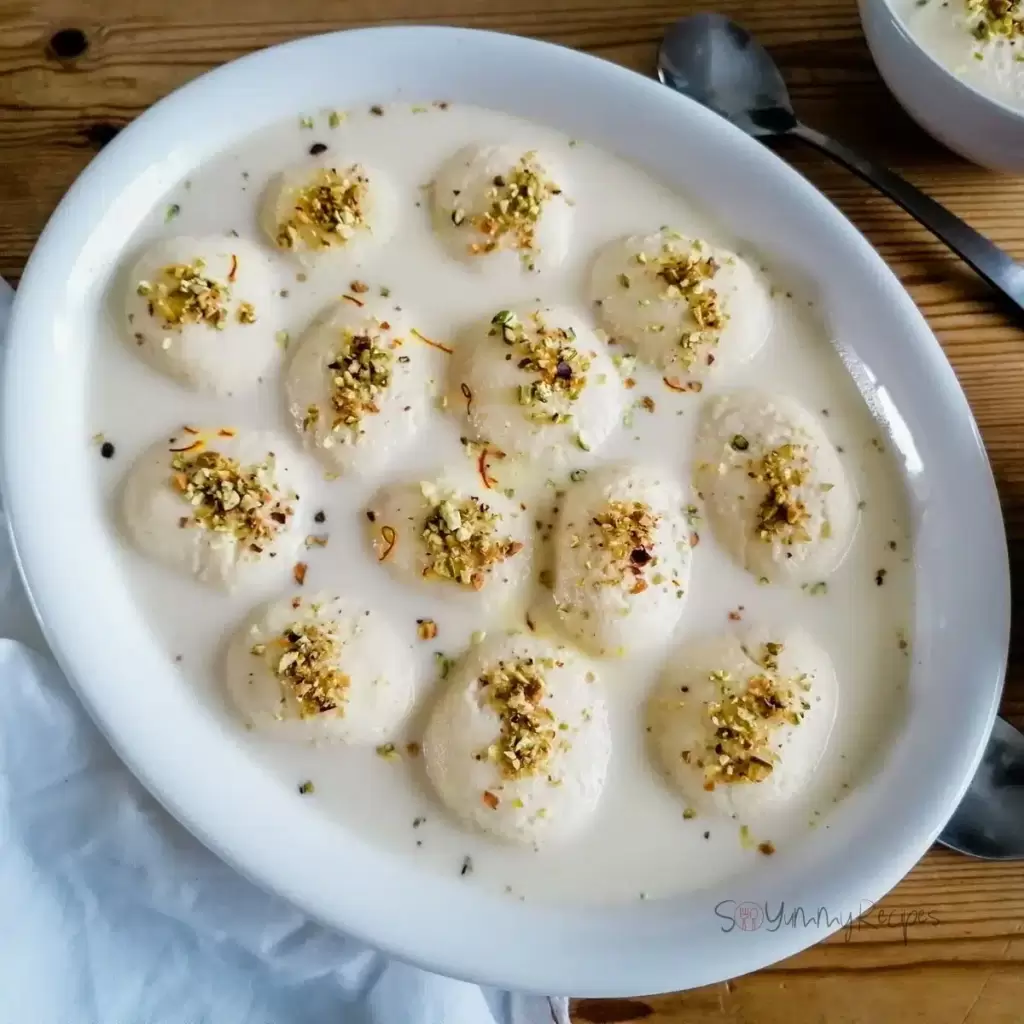The famous Indian dish Rasmalai is a sweet and creamy treat that has won the hearts of many people who enjoy sweets. It is a delicacy that satisfies taste senses with its soft, spongy cottage cheese dumplings drenched in creamy, sweetened milk. However, people with celiac disease or gluten sensitivity may be wary about consuming particular foods if they have dietary restrictions or allergies. To assist those with gluten-related concerns in making educated decisions while indulging in this delicious dessert, we will analyse whether Rasmalai is gluten-free in this article and provide information on its ingredients and cooking techniques.
How To Make Traditional Ras Malai?
It might seem intimidating to make Rasmalai at home, but with the appropriate ingredients and instructions, it can be a fun and satisfying experience. Here is a quick recipe for making tasty Rasmalai:
Ingredients:
In relation to Paneer Rasgulla:
- 2 teaspoons of lemon or vinegar
- 1 cup of sugar
- 1 litre of full-fat milk
Applied to sweetened milk syrup:
- 1 cup sugar, 1 litre full-fat milk, and an optional pinch of saffron threads.
- 1/8 teaspoon powdered cardamom
- Pistachios and almonds chopped for garnish
Instructions:
1. Making Rasgulla (Paneer Dumplings): Bring one litre of full-fat milk to a boil in a big pot.
- Once the milk begins to boil, turn the heat down to low and gradually mix in the vinegar or lemon juice. The curds and whey will separate when the milk begins to curdle.
- Turn off the heat and give it a moment to cool.
- Use cheesecloth or muslin to line a sieve or colander. To separate the whey (liquid) from the paneer (curds), pour the curdled milk through the cloth.
- To get rid of any lemon or vinegar flavour, rinse the paneer in cold water.
- Squeeze the excess water from the paneer carefully using the cloth’s corners. To get rid of any leftover moisture, hang the paneer for around 30 minutes.
2. Preparing the Paneer Dumplings (Rasgulla):
- After 30 minutes, remove the paneer from the cloth and knead it for 5-7 minutes on a clean surface to make it smooth and soft.
- The paneer should be divided into small, equal-sized balls, which you should then gently press into smooth discs.
- Add 2 cups of water and 1 cup of sugar to a different saucepan. It should boil.
- To the simmering sugar syrup, add the paneer discs. The dumplings should be cooked, soft, and spongy after 12 to 15 minutes of cooking over medium heat with a top lid. They will expand while cooking.
- After removing the paneer dumplings from the stove, give them some time to cool in the sugar syrup.
3. Preparing Sweetened Milk Syrup 3.
- Bring 1 litre of full-fat milk to a boil in a separate pot.
- Include 1 cup of sugar and whisk to dissolve.
- If you’re using saffron, add a pinch to a spoonful of heated milk before adding it to the boiling milk for a lovely colour and scent.
- Add cardamom powder to create a rich flavour.
- The milk should be simmered for 5-7 minutes on low heat to slightly thicken it. Continue to stir occasionally.
4. Making the Rasmalai:
- Place the cooked paneer dumplings into the prepared sweetened milk syrup after gently pressing the sugar syrup.
- For at least two hours, let the paneer dumplings soak up the flavours of the milk syrup.
- Adding garnishes:
- After the Rasmalai has thoroughly soaked, top it with chopped almonds and pistachios. Enjoy the delicious homemade Rasmalai while cooled!

Does Ras Malai Have Gluten?
No, ras malai does not contain gluten. As per the above para, we learned how to make ras malai at home, now we have the question Ras Malai may contain gluten or not, it all depends on how it is made. In the past, gluten-free products were not used to make Ras Malai. Cottage cheese, milk, sugar, and almonds are the key gluten-free components used in Ras Malai.
Although ras malai’s ingredients don’t naturally include gluten, some producers add wheat flour to improve the texture of the spongy cottage cheese balls dipped in the rich milk.
It is crucial to remember that different chefs and kitchens may prepare Ras Malai differently. There may be gluten-containing additives or thickeners in some Ras Malai versions. For instance, some milk powder or cottage cheese brands used to make Ras Malai may have traces of gluten.
It is advised to examine the ingredients list or to ask the person or establishment creating the Ras Malai if it contains any gluten. You must be cautious and double-check the ingredients in any dessert, including Ras Malai if you have celiac disease or gluten sensitivity to prevent any possible gluten contamination.
Is Ras Malai Dairy and vegan-free?
No, Ras Malai is not dairy-free or vegan. Ras malai’s primary component is dairy. The best dessert for vegans is therefore not this one.
You can change things in the following ways if you contain dairy free products:
Replace the dairy milk: To prepare the syrup and the “paneer” balls, substitute a non-dairy milk substitute for the usual milk. Because they have a naturally creamy and slightly sweet flavour, cashew milk and almond milk are great options. You can also use any other plant-based milk, such as soy or oat.
Use a vegan cheese alternative: Rasmalai may be made vegan by replacing the cheese Paneer with a dairy-free cheese alternative. Paneer can be directly swapped out for tofu. Tofu with a silky texture can be used to simulate paneer.
Alternative sweeteners: Sugar, which is typically regarded as vegan, is used to sweeten ras malai. You might choose an alternative sweetener, such as maple syrup, agave syrup, or a vegan sugar brand if you are concerned about the methods used to refine the sugar in your region (as bone char can occasionally be used for this purpose).
Recipe Of Gluten Free Rasmalai
Certainly! Here is a recipe for gluten-free ras malai that you could try:
Ingredients:
Rasgulla would need to: One litre of lactose-free milk or any gluten-free plant-based milk (such as almond or coconut milk) and 2 teaspoons of apple cider vinegar or lemon juice, 1 cup of water, 1 cup of sugar
Regarding Rabri (milk sauce) would need: One litre of lactose-free milk or any gluten-free plant-based milk (such as almond or coco, 2 cups lactose-free milk or any plant-based milk free of gluten, 1/2 teaspoon cardamom powder – 1/4 cup sugar, Optional saffron strands, Chopped nuts (such as pistachios or almonds) as a garnish
Instructions:
1. Make the rasgulla: The lactose-free milk should be heated in a big pot until it just begins to gently boil.
– To get the milk to curdle and separate the curds from the whey, add lemon juice or apple cider vinegar. Gently stir until curds begin to form.
– Turn off the heat and give it some time to cool.
– Utilise a fine strainer or muslin cloth to filter the curds. To get rid of the lemony flavour, rinse the curds under cold water.
– To create a smooth dough, gently knead the curds after pressing out any extra water.
– Make smooth balls by dividing the dough into small portions and rolling each one between your palms.
– Prepare the sugar syrup in a different pot by combining sugar and water, then bring it to a boil.
– Add the made balls to the syrup and simmer for about 15 minutes at medium heat. They will swell and grow bigger.
2. To make rabri, heat the lactose-free milk in a separate saucepan and simmer it for 30 to 40 minutes over low heat, stirring occasionally.
– To the simmering milk, add sugar, cardamom powder, and optional saffron threads. Cook the milk further until it thickens and reduces to a creamy consistency.
3. After the Rabri and the Rasgulla balls have both finished cooking, gently squeeze any remaining sugar syrup from the Rasgulla balls.
– The Rasgulla balls should soak in the Rabri for a little while to allow the flavours to blend.
– With chopped nuts as garnish.
You now have a delicious gluten-free Rasmalai that is ideal for anyone who are sensitive to or intolerant to gluten. Without having to worry about gluten-containing components, enjoy this delicious dessert!
To wrap up
In conclusion, Ras Malai does not naturally include gluten, however depending on the precise preparation technique and brand used, it is advised to be cautious and look for potential gluten-containing additives.
For those who seeking gluten-free, dairy milk can be swapped out for alternatives like almond milk or coconut milk, making it appropriate for a wider variety of dietary concerns. The dessert is also completely safe for consumption because gluten-free almonds were used.
Whether made at home or found in speciality stores, gluten-free rasmalai offers a scrumptious treat that brings the authentic flavour of this beloved dessert to all, embracing the diversity of deity needs and preferences. As gluten free awareness grows, experimenting with alternative flours and starches opens up a world of possibilities for creating delightful rasmalai variations that cater to various dietary requirements. With a little creativity and attention to ingredients choice, everyone can savour the rich, creamy, and gluten free indulgence of rasmalai.



